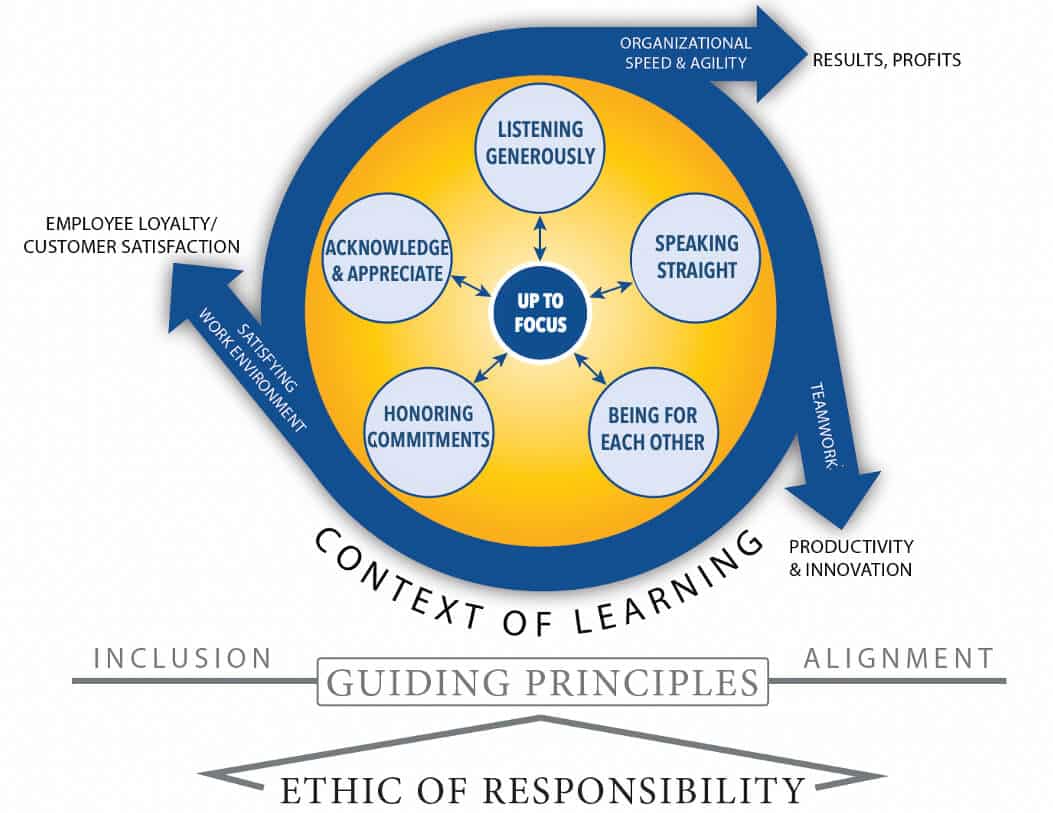
What is the Collaborative Way®?
We all come to the workplace with different backgrounds and expectations about how we’re supposed to work together. As a result, we are prone to ineffectiveness, misunderstanding and upset. In order to create an environment conducive to collaboration, we need to design and take on learning an intentional way of working together. The Collaborative Way® is one such model. It is a simple model that provides mutual understanding and a common language, producing a powerful structure for ongoing coaching and learning. For well over two decades, it has proven its ability to provide a critical strategic advantage and satisfying workplace.
Up To / Focus and Organizational Direction
At the center of The Collaborative Way® diagram is “Up To / Focus”. This represents the objectives that your company is centered around accomplishing such as your vision, mission and/or organizational direction. Collaboration’s success depends upon a company clearly declaring what it wants to accomplish. Without this definition of organizational direction and shorter-term goals and objectives, we don’t know what end we are collaborating towards; the entire process of collaboration becomes unlikely to contribute to the success of the company. The rigor of providing this focus needs to be present at every level of the company: from defining the organizational direction to declaring the purpose and objectives of a meeting or discussion. All the other practices of The Collaborative Way® then provide a powerful environment for accomplishing these objectives.
The Collaborative Way® Core Practices
Explore the core practices of The Collaborative Way® by clicking on the the tabs below. Surrounding the “Up To / Focus” are the five core commitments/ practices of The Collaborative Way®. These practices define how we are going to work and relate together in the company so as to accomplish your objectives in the most direct way. Below the circle of practices on The Collaborative Way® diagram are the guiding principles: Alignment and Inclusion, which are critical to sustaining an environment of collaboration. Cradling the circle is Context of Learning, the guiding force in keeping the practice vital.
Listening by Habit
A major source of lost productivity stems from how we tend to listen to each other. Listening by habit too often dominates our communication: When conflict arises, we get locked into our point of view, only able to hear what supports our viewpoint. When collaboration is called for, we often set our arguments against each other and persist in trying to sell our ideas. In this environment of listening, mistakes and misunderstandings thrive, and energy, resources and time are wasted. However, if we break from our habits of listening and engage in the practice of Listening Generously, conflict and collaboration can play their essential roles in a company’s success. We can then begin to steer ourselves from no-win situations into courses of action that provide greater productivity.
Listening Generously

The practice of Listening Generously addresses the shortcomings in the way we normally listen. However, a few good listeners in an organization are not enough. The key is establishing an environment of mutual support throughout the company for the practice of Listening Generously. When we are listening generously we are:
- Giving our full attention to the speaker
- Curious and willing to be influenced
- Setting aside our prejudices, preconceived conclusions and judgments
- Not waiting for an opening to argue our point or thinking of our rebuttal
“The challenge is to remain present and focused as someone else is talking. My inclination has been to do many things at the same time: to be working on my computer, planning out what I’m going to be doing after this conversation, to think about whose call I have to return. I find that it takes a lot of rigor and a lot of concentration to stay focused on a conversation, especially when I have some history with someone. I find that I’m filtering what they’re saying to me and trying to manage what I’m going to say back rather than staying present and being curious.”
– Larry Friedman (VP of Operations, RSI)
Company-wide benefits of the practice of Listening Generously
- Better ideas and more informed decisions that are implemented more quickly
- Productive use of conflict
- An energized workforce
- Fewer mistakes and misunderstandings
- Greater understanding of customer needs
“. . . I was telling someone else in my company about how I felt about an exchange. He said, ‘You sound pretty defensive at the moment. I wonder how you’re listening?’ So we used The Collaborative Way®. When they pointed this out to me, I said, ‘Oh, yes. That’s it!’ And then I read it in a whole different way and had a new conversation with completely different results.”
– Steve Hutton (President, The Conard-Pyle Company)
“Listening Generously is an extremely active game . . . It turns the simple act of listening into a practice of discernment. If I work hard at letting my employees know that I’m listening – and I try to do that by asking some good questions as we go along – that kind of shocks them into the reality that ‘wow he’s really listening to this!’ One of the great things about The Collaborative Way, in my experience, is that it’s one of the few things that you can learn in business and then apply to your whole life.”
– Ross Myers (CEO, Allan Myers)
Unproductive Speaking
The way we speak at work too often involves playing it safe – voicing what’s comfortable and reflecting only what we think we’re supposed to say – or it’s vague and leaves false impressions. As a result, productivity suffers; one example of which is the ineffectiveness of many company meetings. These meetings either end in poor decisions because not all of the participants contributed their intelligence or they end in decisions that don’t have everyone’s full support or understanding. This lack of support and/or understanding isn’t discovered until the implementation process begins and then yet another meeting becomes necessary, which will often be as ineffective as the first unless the real problem, our way of speaking, gets addressed. The practice of Speaking Straight gives companies the ability to deal with this root issue and, as a result, become faster and more effective.
Speaking Straight

Establishing the practice of Speaking Straight is critical to addressing the challenges to our productivity. As we practice Listening Generously, we build an environment conducive to Speaking Straight. Through continued support and practice we build the rigor and quality of our speaking so that we are:
- Speaking up when we have something relevant to contribute
- Speaking honestly while making a contribution
- Bringing up issues that need addressing even at the risk of conflict and discomfort
- Making clear and direct requests and getting committed responses
“One of the areas that we’ve really benefited from Speaking Straight is when an employee speaks up to someone who is their boss. Many times the employee feels that he can’t talk to this person. We’ve really worked hard at turning that around. Without this, I never would have heard the contributions that I’ve gotten.”
– Mike Goodman (President, Metallurgical Products Company)
Company-wide benefits of the practice of Speaking Straight
- More productive meetings
- Higher quality of collaborative thinking resulting in better decisions
- Faster implementation of initiatives by dealing with the real issues up front
- Greater skill at managing requests and handing off tasks with fewer mistakes
- Employees who feel respected and part of the game
“What we’re getting from Speaking Straight is faster and higher quality decisions and actions. With this practice, we can get all the issues about a certain situation on the table – more information than we would if someone was having a hard time with straight speaking”
– Ed Stopper (President, Elray Manufacturing Company)
“What prevented me from Speaking Straight in the past was that I simply wanted to avoid uncomfortable situations and put off something I didn’t view as a lot of fun. What I’ve discovered is that this really makes the problem worse and slows down a process that could make it better.”
– Gordon Bryan (VP, Career Development, Allan Myers)
Lack of Mutual Support
Even though a company’s success depends upon our mutual support and teamwork, we too often focus on personal success. With this focus, our competitive drives push against each other rather than pull us together against outside competitors; or our support extends primarily to our immediate department, and battles between business units ensue. If something goes wrong in this environment, we are often quick to question each other’s intentions or jump to blame, slowing down the process of dealing with the real issue. We withhold support from others, which prevents us from dealing with individuals’ and departments’ performance issues until they reach a crisis point. All of these unproductive behaviors slow us down and make it more difficult to reach our goals. The practice of Being For Each Other deals with these issues and gives us both a great place to work and a more powerful company.
Being For Each Other

Committing to and practicing Being For Each Other makes a significant difference in overcoming a lack of mutual support in the workplace. It’s a measured and rigorous way of relating that moves support beyond being nice to each other. Through continued practice of Being For Each Other, we build an environment where we:
- Support each other’s success
- Re-direct gossip into productive discussions
- Actively and quickly deal with performance issues
- Quickly clean up issues and misunderstandings that affect our working relationships
“For me, being for somebody is a whole orientation to being for their success. And, if I’m really clear about that on a fundamental level and am really truly for someone’s success, I simply ask myself, well what does that demand of me; if it demands that I have a difficult conversation, then that’s what is necessary for their success. So, if they need to hear something from me to help them be successful, then no matter how uncomfortable that might be, if I’m for them, I have to do that. It’s not about nice necessarily, but about being for them.”
- David Friedman (President, RSI)
Company-wide benefits of Being for Each Other
- Competing against our competitors rather than against each other
- Working together across business units and departments for the success of the company
- Attracting and keeping the best and brightest people
- Employees who feel respected and part of a unified company
- Ability to deal with tough work and personal issues more quickly and effectively
“Part of the challenge we face in Being For Each Other is carrying out actions to support somebody else when it looks like it’s going to cause me some negative effects. Recently, the business unit I lead gave up some really talented personnel to support other business units, and, at first, it was hard to swallow. I perceived it as a weakening of our team at someone else’s gain. Then I thought about it a little bit and realized it was the right thing to do. I saw it as an example of Being For Each Other and I fully supported it. Our unity in practicing this skill makes us, as a company, stronger and more competitive. And it’s another example of the way we use all of our principles of The Collaborative Way to collectively get better.”
- Rob Baccala (VP, General Manager, Allan Myers)
“Another important part of Being For Each Other is encouragement. I’ve seen people stretch their ability and stretch their energy and stretch everything when people have given them the encouragement at the right time. I think it’s real important as part of The Collaborative Way that we all take the time to do that. And, you don’t have to be a manager to someone who is working for you. It can be from any person to another in the company. Encouragement and Being For Each Other can go any direction in the organization and can come from anyplace.”
– Bob Capps (Director Recruiting & Retention, Allan Myers)
Mishandled Commitments
We limit our ability to provide the highest level of customer satisfaction when we mishandle our commitments to each other. Our mishandling contributes to an environment of blame and finger pointing that distracts us from our customers: We often get defensive and/or demean each other when a commitment breaks down instead of looking to its source, which could be as simple as a miscommunication about the commitment’s details. Mishandled commitments also contribute to a loss of morale and an increase in cynicism: We start to lose our passion for participating in the success of the company and resignation often sets in when company-wide commitments are made, not followed through on, and then ignored. The practice of Honoring Commitments eliminates these unproductive effects and provides a framework for working together towards the realization of a company’s vision.
Honoring Commitments

The practice of Honoring Commitments provides a powerful tool for accomplishing our goals. But it’s a tool that requires a high level of rigor, extending from a commitment’s conception to its realization, including dealing with any of its breakdowns. This rigor is required from both sides of the commitment; both the maker and receiver are active participants in its success or failure. Once we have made the practice of Honoring Commitments a way of relating, we are:
- Ensuring that only clearly defined commitments are made
- Immediately communicating when a commitment is at risk of not being kept
- Quickly and effectively addressing commitments that are not kept
- Effectively supporting each other in fulfilling our commitments
“The important thing we’ve learned about Honoring Commitments is that it’s not a “sometime” thing. Success lies in people truly believing that every commitment has value — little ones, big ones, those you extend, those you receive. And we’ve gotten very disciplined about the idea that the responsibility for a commitment lies with both parties.”
– Mike Diccicco (President, Diccicco Battista Communications)
Company-wide benefits of Honoring Commitments
- Greater effectiveness at implementing change efforts
- A winning environment that people want to work in
- Higher productivity due to greater cooperation among employees and among business units
- Increased customer satisfaction due to effective handling of commitments
- Greater ability to attract and retain the best talent
“During stressful times, such as those caused by limited production capacity, Honoring Commitments is essential to building internal relationships, trust and staying connected. It is especially powerful in the manufacturing sector with this drive for speed and on time delivery. In Honoring Commitments, we are bringing more success to our transactions with our customers, with our vendors and with each other. In Honoring Commitments, we’re also strengthening the organization, strengthening the trust among each other and then being able to attain our goals and visions together.”
– Bill Stockwell (President, Stockwell Rubber Company)
“So much of our credibility as an organization comes from how our managers interact with our clients. Our “word” and follow through actions must truly be “as good as gold.” The conscious practice of Honoring Commitments provides the foundation for us to be the best at being a company “of our word.” Our mangers have learned that the practice involves both the giver and the receiver being equally responsible for seeing that the commitment is met. When someone is told, “Oh, don’t worry; I’ll take care of that issue,” it is now the norm, where it was once the exception, for someone in our organization to say, for instance, “Can I have a definite time, date, format, etc. when that will be accomplished and I will check in with you next Wed. to see the progress; is this OK with you?” The beauty of this process is that it carries over to the marketplace and a level of credible trust is built with clients that provides for long lasting relationships.”
– Brian S. Blair (President, Brandywine Building Services, American Seaboard Exteriors and American Seaboard National)
Incomplete Acknowledgement
When there is a scarcity of acknowledgement in a company, “coasting” can become the common work mentality. We feel unappreciated when there’s little acknowledgment and tend to only do the things we have to do; we’re unlikely to take on big tasks that might put as at risk or require more of us, but which are essential to a company’s productivity and innovation. Our lack of a sense of appreciation also contributes to the unproductive complaining we do about our jobs, our work environment and our co-workers. Unfortunately, when we are given acknowledgement, it’s often incomplete and unspecific and easy for us to write off or mistrust. We are left with the sense of still being unappreciated. The practice of Acknowledgment and Appreciation addresses these issues; it develops our sense of belonging and encourages us to contribute to a company’s success.
Acknowledgement & Appreciation

Establishing Acknowledgment and Appreciation in a company is key to realizing the full potential of its workforce. However, the power of acknowledgment is limited when it’s constrained in a top-down funnel, where only superiors acknowledge those who work under them. Acknowledgement is most powerful when everyone in a company is looking to give it, regardless of the direction. When Acknowledgment and Appreciation becomes a company-wide activity, we are:
- Giving acknowledgement that is specific and meaningful
- Receiving acknowledgement openly and expressing our thanks
- Requesting acknowledgement be given when it is missing somewhere in the company
- Taking on things we wouldn’t normally do
“I found I really had to spend time before I acknowledged someone, making sure I really understood what happened: what all the implications and ramifications of the actions were, how it benefited the customer, how it benefited the organization, how it was taking us closer towards the company we want to be someday. When the acknowledgement was given with those facts, it became much easier for people to receive it and trust it, because they understood why they were getting it. I really believe if we all look at our organizational goals and the things we are trying to achieve and then find people that are taking us closer to those goals, private acknowledgement will bring out their energy and public acknowledgement will become an extremely powerful tool to get everyone going in the direction we need to go in as an organization. It becomes more of, ‘OK, that’s where we all want to go.’ It becomes a lot of fun. It brings fun into the work place, which I find, without some fun, work is work.”
– Ross Myers (CEO, Allan Myers)
Company-wide benefits of Acknowledgement and Appreciation
- More committed and energetic workforce
- Satisfying and positive work environment
- Ability to attract and keep the best talent
- Increased effectiveness in implementation of change efforts
- Greater company-wide partnership in the mission of the company
“A part of us is ready to deflect appreciation; it’s the way we have been brought up. It is a part of being humble that instead of wrapping our arms around it when it comes our way, we tend to say, ‘well, that was really so and so that did most of that,’ and mitigate it in some way. Appreciation is such a wonderful gift that, boy, be ready to receive it the times it comes your way and enjoy it for what it is. My own way of looking at it is just that, a gift. If you don’t accept the gift of acknowledgement, then you are not honoring the person who extended themselves to give it to you.”
– Steve Hutton (President, The Conard-Pyle Company)
“An organization that can effectively acknowledge and appreciate its employees – up, across, down and all over the organization – is going to release an incredible amount of energy towards getting things done. An organization that has energy being released is an organization that has passion. And a passionate organization is going to differentiate itself and be successful today.”
– Larry Friedman (VP of Operations, RSI)
Two Guiding Principles:
Inclusion:
Becoming effective at Inclusion is essential to effective collaboration. A workforce that is not included in the big picture, including the realities of its marketplace, will not be effective at collaborating. When we skillfully include others in the decision making process, we end up with better and more informed decisions. It’s also easier to gain the needed support to implement the decision, and being included reinforces people’s ownership of their accountabilities.
Alignment:
The key to Alignment is keeping alive the question, “Are we addressing the issue, policy or problem with a regard for building alignment?” versus forcing our view or merely going along with the prevailing view. While there are times we must take action without taking the time to build alignment, if we make this our standard mode of operation, we will kill the collaborative energy in our company. It takes skillful use of all the practices of The Collaborative Way® to gain the true power of Alignment.
Context of Learning
The initial training in The Collaborative Way® is only the beginning of a practice that invites us to continually learn a new way of working together. The powerful structure for continued coaching that The Collaborative Way® provides extends our opportunity for learning from the formal training sessions into our day-to-day business interactions. We get the most value out of this opportunity for continued learning when we take on the practice in a Context of Learning – when we realize no one will ever master the principles and recognize that the challenge is to continue to learn and be open to others‘ support in our learning. In this context, the principles of The Collaborative Way® are not ideals or standards to be used to denigrate ourselves or others with; rather, they are an opening for continuous improvement.
“My own experience with The Collaborative Way® is that, early on, I believed that learning the principles was a destination – that someday I would master The Collaborative Way®. The truth is that mastering the principles is a journey, one that never ends and one you must personally commit to in order to keep alive. It’s a process of continual learning that includes coaching others in their practice as well as being open to receiving coaching. It’s not the destination that matters; it’s how you take the journey.”
– Bob Herbein (Executive VP of Corporate Services, Allan Myers)
Implementing The Collaborative Way®
You are invited to contact us to explore how we can work with you to produce this result for your company.
